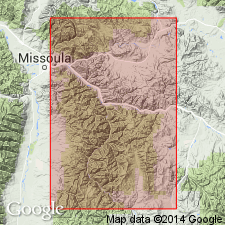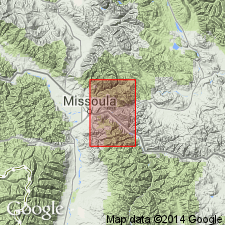
- Usage in publication:
-
- Sheep Mountain formation
- Modifications:
-
- First used
- Dominant lithology:
-
- Quartzite
- AAPG geologic province:
-
- Northern Rocky Mountain region
Summary:
First published use as the upper formation (of five) of Missoula group (first used) of Belt series. Intent to name not stated. Type locality is the upper 1,000 ft of Sheep Mountain, sec 24, T15N, R18W and sec 30, T14N, R17W, Missoula Co, MT in the Northern Rocky Mountain region. Overlies Garnet Range formation (first used) of Missoula group. Is 2,300 ft thick on Sheep Mountain where it is composed of red, pink, and white, massive, generally coarse-grained, cross-bedded quartzite. Has numerous bands of clay balls, especially near base and top. Weathers gray-red to deep red. Correlation chart. Columnar section. Of Algonkian age.
Source: GNU records (USGS DDS-6; Denver GNULEX).

- Usage in publication:
-
- Sheep Mountain formation*†
- Modifications:
-
- Abandoned
Summary:
Abandoned as a unit in the Missoula group of the Belt series in Missoula Co, MT in the Northern Rocky Mountain region. Name Sheep Mountain has been applied to another formation [in southwest CO]. Rocks formerly called Sheep Mountain are reassigned to the Pilcher formation (new) of the Missoula group of the Belt series.
Source: GNU records (USGS DDS-6; Denver GNULEX).
For more information, please contact Nancy Stamm, Geologic Names Committee Secretary.
Asterisk (*) indicates published by U.S. Geological Survey authors.
"No current usage" (†) implies that a name has been abandoned or has fallen into disuse. Former usage and, if known, replacement name given in parentheses ( ).
Slash (/) indicates name conflicts with nomenclatural guidelines (CSN, 1933; ACSN, 1961, 1970; NACSN, 1983, 2005, 2021). May be explained within brackets ([ ]).

